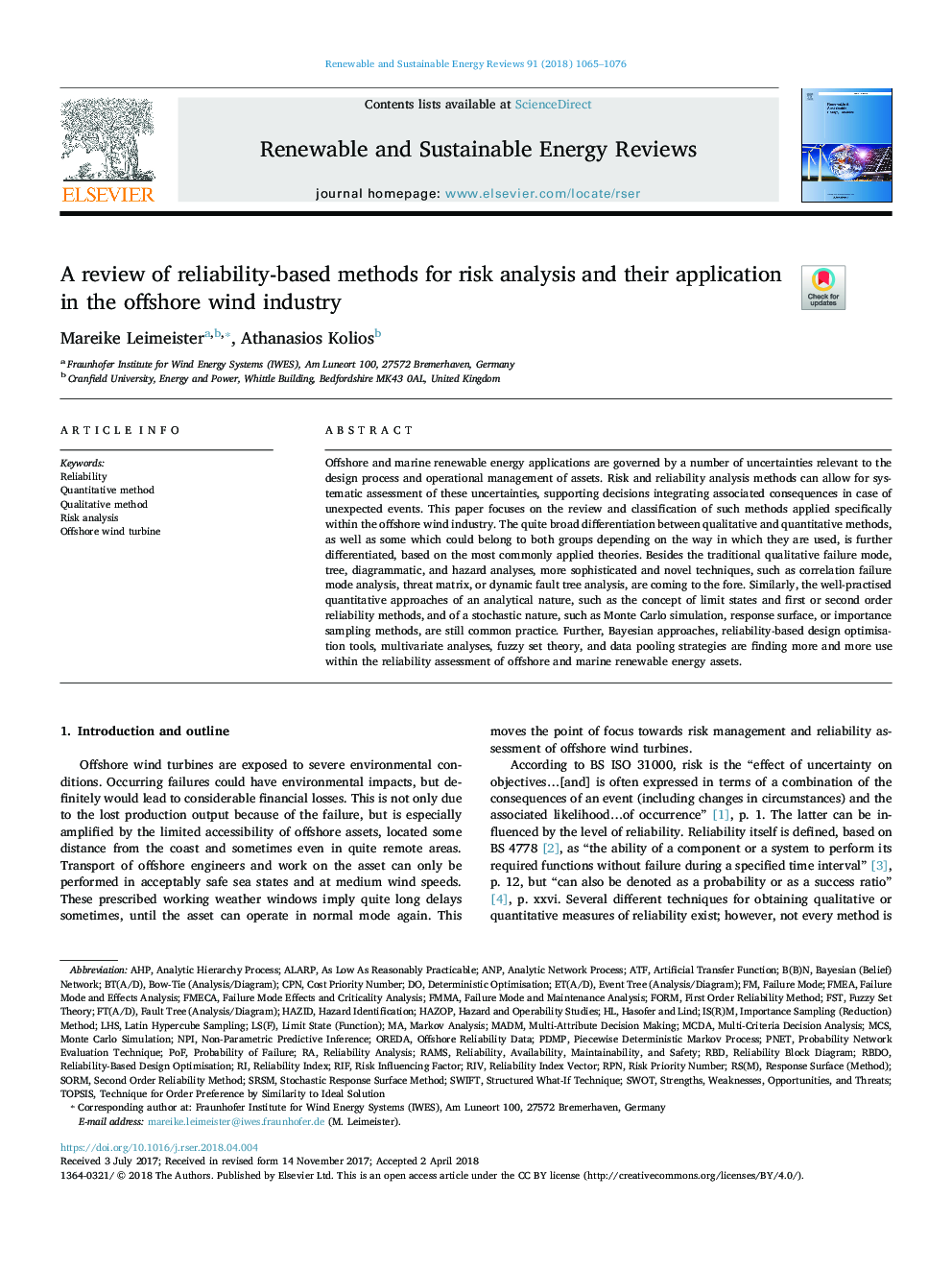| کد مقاله | کد نشریه | سال انتشار | مقاله انگلیسی | نسخه تمام متن |
|---|---|---|---|---|
| 8111266 | 1522293 | 2018 | 12 صفحه PDF | دانلود رایگان |
عنوان انگلیسی مقاله ISI
A review of reliability-based methods for risk analysis and their application in the offshore wind industry
ترجمه فارسی عنوان
بررسی روش های مبتنی بر قابلیت اطمینان برای تحلیل ریسک و کاربرد آنها در صنعت باد در دریای خزر
دانلود مقاله + سفارش ترجمه
دانلود مقاله ISI انگلیسی
رایگان برای ایرانیان
کلمات کلیدی
ANPPOFNPIPNETFMEAPDMPFSTRBDCPNRIVMCsATFSWOTFMECAALARPMCDAHAZOPLHSMADMSORMRPNRBDOStochastic response surface methodRAMs - RAM هاRisk analysis - آنالیز ریسکProbability of failure - احتمال خرابیReliability block diagram - بلوک قابلیت اطمینانAs Low As Reasonably Practicable - به عنوان کم به عنوان منطقی قابل اجراMarkov analysis - تجزیه مارکفMulti-Criteria Decision Analysis - تجزیه و تحلیل تصمیم گیری چند معیارReliability analysis - تجزیه و تحلیل قابلیت اطمینانMulti-attribute decision making - تصمیم گیری چند ویژگیOffshore wind turbine - توربین بادی دریاییTechnique for Order Preference by Similarity to Ideal Solution - تکنیک برای ترجیح سفارش توسط شباهت به راه حل ایده آلFailure mode and effects analysis - حالت شکست و تجزیه و تحلیل اثراتFailure mode - حالت شکست یا حالت خرابیHAZID - خانهSecond order reliability method - روش اطمینان دوم مرتبهFirst order reliability method - روش اعتماد به روش اولTOPSIS - روش تاپسیسMonte Carlo Simulation - روش مونت کارلوQuantitative method - روش کمیQualitative method - روش کیفیAnalytic hierarchy process - روند سلسله مراتب تحلیلیSwift - سریعReliability index - شاخص قابلیت اطمینانRisk Priority Number - شماره اولویت خطرHazard identification - شناسایی خطرAnalytic Network Process - فرآیند شبکه تحلیلیAHP - فرایند تحلیل سلسلهمراتبیPiecewise deterministic Markov process - فرایند مارکف قطعی و قطعیForm - فرمReliability - قابلیت اطمینانFuzzy set theory - نظریه مجموعه فازیLatin hypercube sampling - نمونه برداری لاتین هپقوبRif - کد عکس
ترجمه چکیده
برنامه های کاربردی انرژی تجدید پذیر دریایی و دریایی توسط تعدادی از عدم اطمینان مربوط به روند طراحی و مدیریت عملیات دارایی ها اداره می شود. روش های تحلیل ریسک و قابلیت اطمینان می تواند برای ارزیابی سیستماتیک از این عدم قطعیت ها، پشتیبانی از تصمیمات، ادغام عواقب مرتبط با آن در صورت وقوع رویدادهای غیر منتظره را امکان پذیر سازد. این مقاله بر بررسی و طبقه بندی چنین روش هایی بخصوص در صنعت باد در دریای خاورمیانه تمرکز دارد. تمایز کاملا وسیعی بین روش های کیفی و کمی و همچنین برخی از آن ها که می تواند به دو دسته تقسیم شود، بر اساس شیوه استفاده از آنها، بر اساس نظریه های رایج ترین کاربردی متفاوت است. علاوه بر حالت های شکست کیفی سنتی، درختان، نمودارها و تجزیه و تحلیل خطر، تکنیک های پیچیده تر و جدیدتر، مانند تجزیه و تحلیل حالت شکست همبستگی، ماتریس تهدید، و یا تجزیه و تحلیل درخت گسل پویا، به جلو می آیند. به طور مشابه، رویکردهای کمی در مورد ماهیت تحلیلی نظیر مفهوم حالتهای محدود و روشهای اعتبارسنجی اول یا دوم و طبیعت تصادفی مانند شبیه سازی مونت کارلو، سطح پاسخ یا روشهای نمونهگیری اهمیت هنوز تمرین معمول علاوه بر این، رویکردهای بیزی، ابزارهای بهینه سازی طراحی مبتنی بر قابلیت اطمینان، تجزیه و تحلیل چند متغیری، نظریه مجموعه فازی و استراتژی های تلفیقی داده ها، در استفاده از منابع انرژی تجدید پذیر دریایی و دریایی بیشتر و بیشتر مورد استفاده قرار می گیرند.
موضوعات مرتبط
مهندسی و علوم پایه
مهندسی انرژی
انرژی های تجدید پذیر، توسعه پایدار و محیط زیست
چکیده انگلیسی
Offshore and marine renewable energy applications are governed by a number of uncertainties relevant to the design process and operational management of assets. Risk and reliability analysis methods can allow for systematic assessment of these uncertainties, supporting decisions integrating associated consequences in case of unexpected events. This paper focuses on the review and classification of such methods applied specifically within the offshore wind industry. The quite broad differentiation between qualitative and quantitative methods, as well as some which could belong to both groups depending on the way in which they are used, is further differentiated, based on the most commonly applied theories. Besides the traditional qualitative failure mode, tree, diagrammatic, and hazard analyses, more sophisticated and novel techniques, such as correlation failure mode analysis, threat matrix, or dynamic fault tree analysis, are coming to the fore. Similarly, the well-practised quantitative approaches of an analytical nature, such as the concept of limit states and first or second order reliability methods, and of a stochastic nature, such as Monte Carlo simulation, response surface, or importance sampling methods, are still common practice. Further, Bayesian approaches, reliability-based design optimisation tools, multivariate analyses, fuzzy set theory, and data pooling strategies are finding more and more use within the reliability assessment of offshore and marine renewable energy assets.
ناشر
Database: Elsevier - ScienceDirect (ساینس دایرکت)
Journal: Renewable and Sustainable Energy Reviews - Volume 91, August 2018, Pages 1065-1076
Journal: Renewable and Sustainable Energy Reviews - Volume 91, August 2018, Pages 1065-1076
نویسندگان
Mareike Leimeister, Athanasios Kolios,
